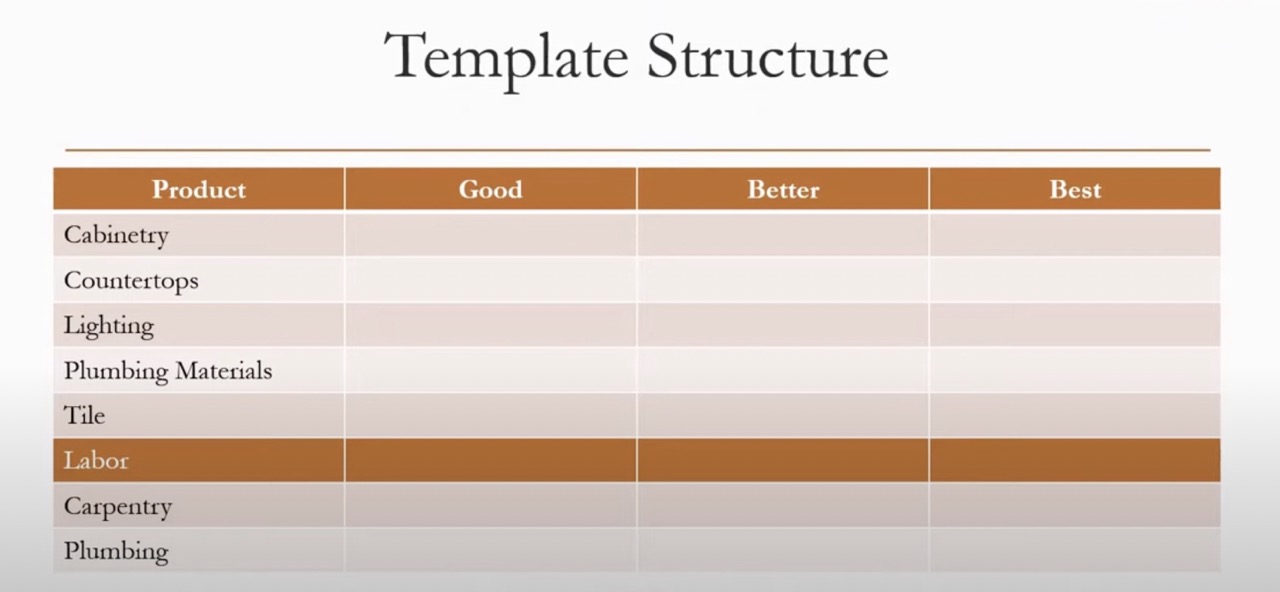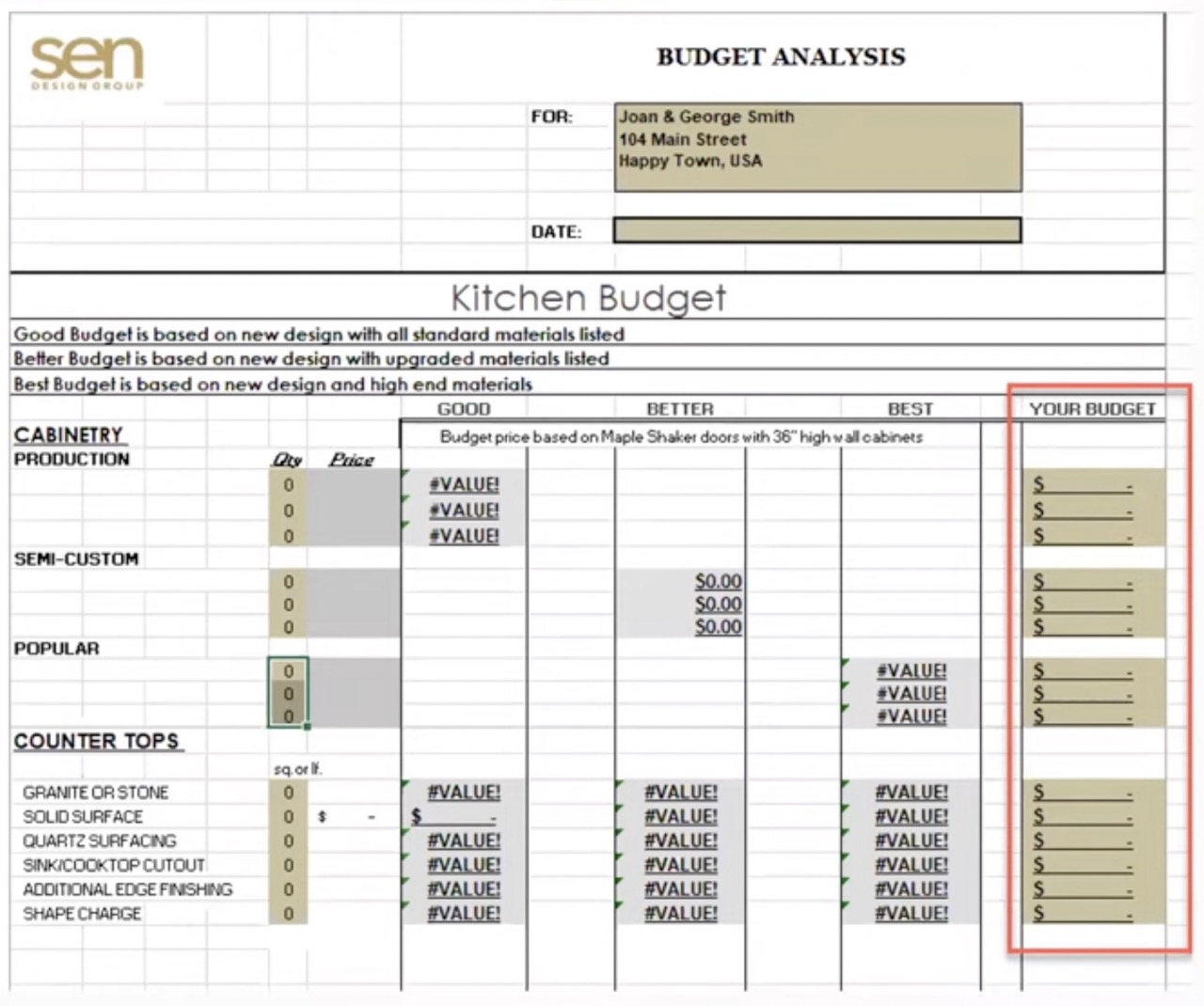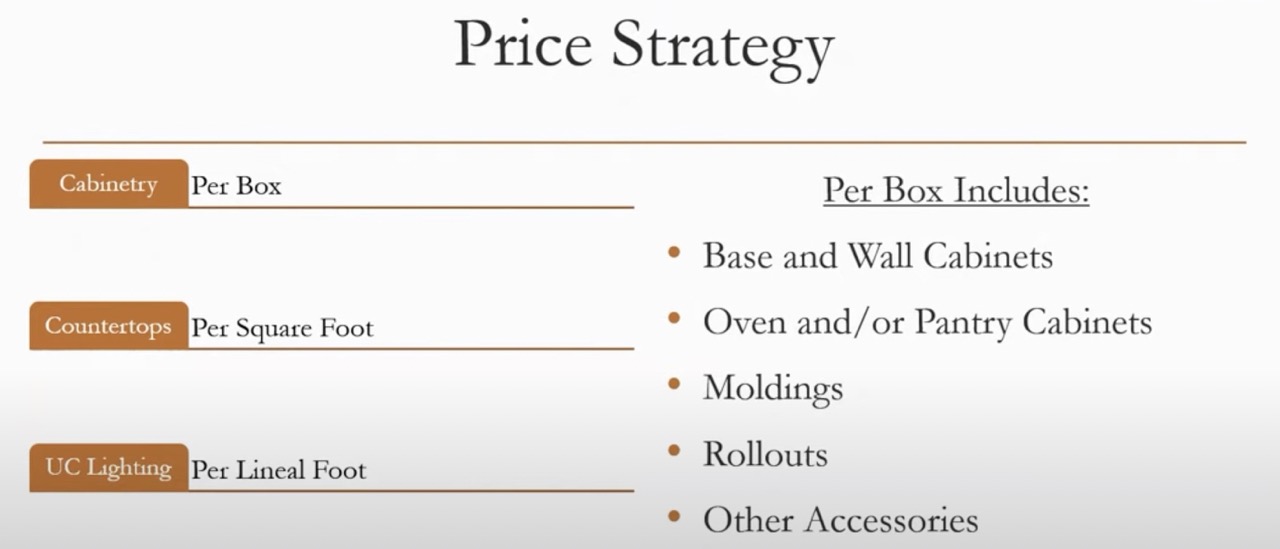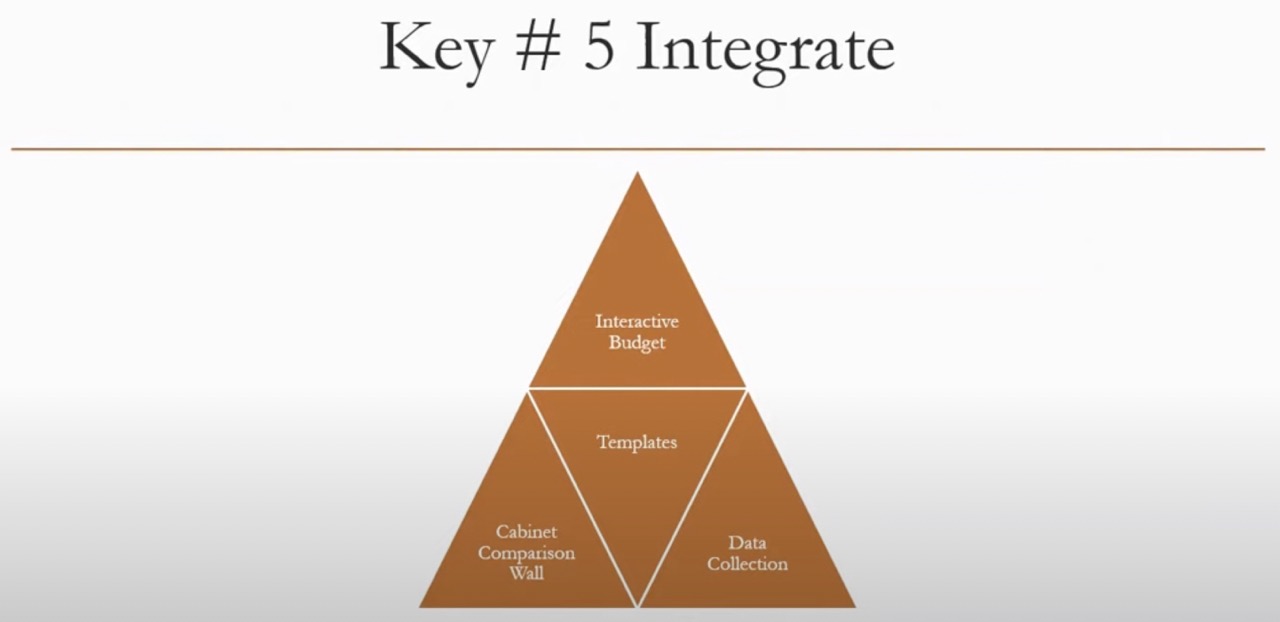“Since we started using the DesignAlign program, we were able to get retained much quicker and spend our time effectively working with clients that have already made a financial commitment with us.”
In the effort to support trust-building between homeowners and small design firm owners, comparative budgeting steps in as a revelation to home remodeling. Leaders such as Ray Dalio and Rand Fishkin come to mind as proponents among many of the transparency revolution.
There is still a fear or sense of dread among owners when we think of being transparent with our customers. Some of us may not want customers to see the inner workings of our business because they may not like what they see. There’s the traditionality of sticking to “what we’re comfortable doing – selling kitchens and baths the way that we always have.” These notions prevent independent kitchen and bath owners from earning much higher ROIs and stimulating sustainable growth for their firms.
This article discusses comparative budgeting from the inside out. It investigates what comparative budgeting does to improve customers’ confidence in the sales designer, the firm they represent, and how it makes the confusing process of buying a remodeling job clear and therefore much less stressful for the homeowner.
This paper is useful for investigating why comparative budgeting should be adopted.
- Discusses how to implement comparative budgeting into operations
- Introduces software that complements comparative budgeting techniques
- Shows how DesignAlign agitates substantial profit growth when used with comparative budgeting
- Why is it necessary to integrate and then master comparative budgeting and proficiency in DesignAlign to see lasting gross profit increase
Understanding Comparative Budgeting
Comparative budgeting is a sales process of transparent interaction that empowers customers to understand the costs and processes involved in completing an investment product.
Empowerment for customers is achieved through two-way disclosure. Generally, the first part may be considered a “discovery” period during which the prospect informs the sales designer of their wants and needs regarding their remodeling idea.
The sales designer collects information from the prospect. The most useful information is typically found in photographs and measurements of the existing space to be remodeled.
The benefits of comparative budgeting: A nine-point revelation
As a sales designer discusses the universe of home remodeling options with a prospect, the prospect’s options for their remodeling project become clearer. The empowering aspect of comparative budgeting is found in juxtaposing this universe of remodeling options and knowledge of the process with knowledge of what products and services cost.
As sales designers involve their prospects in the budgeting process, prospects can create three budget ranges of their own design, seeing how the budget ranges are justified by the numbers comprising them.
Seeing how the budget rangers are justified by product cost, the prospect can then select the budget range to which they are comfortable making an investment.
The prospects’ curative position affirms this process’s success, as it sees all of the moving parts of their design and their monetary cost as expendable after will.
This nexus of knowledge and choice is powerful psychological leverage for the sales relationship, as the prospect’s decision-making capability affirms it.
By design, comparative budgeting offers three budget ranges created in full transparency, thereby reinforcing the notion of intelligent choice and control that comprise the fabric of its empowering nature.
- Clarifies the process – Comparative budgeting takes the stressful task of sorting through product options, technical specifications, and the conundrum of turning the homeowner’s existing space into the desired result by tangibilizing the process for the homeowner.
- Creates partnership – Comparative budgeting is conversational, making it naturally expeditious for establishing and building on partnerships.
- Guidance over selling – The sales designer has a unique misnomer applied to their title because successful sales designers are more like safari guides, taking the bewildered, excited tourist through the jungle and pointing out to name and discuss the animals, places of interest, trees, and vegetation, they see along the way. Such demonstration of knowledge is profoundly impactful to the prospect as it is to the tourist. Like tourists, homeowners who have an outstanding experience at a showroom will recall it and mention it in stories of how they came to get their new kitchen into their home with their friends and families first as long as they’re in that home.
- Convenience – DesignAlign delivers the convenience of millions of products and prices at the sales designer’s and prospect’s fingertips. Agreements, Good-Better-Best sales applied templates, and other critical tools needed for content creation and management of a home remodeling job are organized through the platform.
- Centralizes data – Good-Better-Best sales software becomes the quick reference for anything job-related, whether existing potential or locatable, in a central database easily accessible to anyone on the team. Through centralized data, get the same information delivered quickly no matter whom they talk with. In addition to speeding up the time it takes to arrive at installation day, sensualized data is a confidence builder in the mind and pocket of the homeowner.
- Visual aspects – Imagine giving interactive presentations to prospects in their first consultation with your firm. DesignAlign assists homeowners in exploring options quickly and easily, leading them to make decisions they will be happy about in the long run faster. From material choices to project timelines, visual displays raise the homeowner’s excitement about completing their project.
- Communication – Kitchen and bath firms will save time by stimulating team focus, and their ability to service customer needs faster and more accurately, by eliminating many administrative tasks through automation.
- Interactions – DesignAlign comes with workflow automation – streamlines repetitive tasks – follows up emails, updates project information, enhances efficiency, and reduces the likelihood of oversight. Effective communication – the backbone of remodeling sales – software real-time, a collaboration between contractors and homeowners.
- Instantaneous results—Feedback and updates are given quickly and ubiquitously in real-time, so everybody on the team is on the same page.
Three approaches to sales
The appeal of visual product displays creates clear boundaries that make it easy for customers to understand different pricing options. When kitchen and bath firms offer visual clarity on a large investment decision, they’re taking another step to diffuse the anxiety that naturally crops up in the homeowner swarmed by options and deals in a world of pricing and processes with which they often do not have familiarity.
Defensive approach: Defensive sales is a strategy used to avoid market competition by representing less expensive, herein called good options, that resonate with customers who find value in low-priced items. This approach positions a firm to win an edge over the competition by offering three prices below competitive marketing prices.
Offensive approach: Maximize revenue through upselling. Attractive and value-packed better and best tears encourage customers to opt for the higher-priced options by offering them more. The products and services cost more, but not that much more (not double), and you get a lot more for that cost.
Customer-centric approach: By its nature, Good-Better-Best sales approach home remodeling from the customer’s point of view. It’s a purchasing platform, naturally customer-centric, that is stratified. That stratified products into quality groupings quickly educates consumers on the university products available. products are centrifugal to the kitchen remodeling process as cabinets get a full unpacking explanation in a matter of seconds via visual display.
Pricing
The critical step in selecting the offerings that constitute each price point tier is choosing numbers that make sense to the customer and how the offerings are presented. Price points should reflect perceived value for each year and be triply competitive in the market.
- The good offering should be 25% less than the better one, and the best one should be 50% more
- When presenting options to customers, start with the best offering and work your way down to the good offering
- Think DELTA: each component of the tier structure should create logical separation and pricing differences that demonstrate clear reasoning the consumer can readily understand
- The attributes of each offering should be reflected in its price, and no more than four product features should differ between the offerings.
- Through your product displays, show your prospects how their world will look and feel once their remodeling installation is complete in their home.
Numbers must make sense and reach versatile markets – The price setup should reflect the competitive markets wherein:
- Good options compete with low-cost sellers who reach the bargain-motivated purchaser
- Better options attract customers with middle-price bias
- Best options compete with luxury designers and brand-focused consumers
The SEN Design Group Approach
An approach to comparative budgeting is founded on building a trustworthy relationship with prospects. Trust builds relationships, leads customers to upsell themselves, and brings customers back into your showroom.
It’s in the first showroom meeting that a prospect’s aspirations and concerns come together with a sales designer who listens to prospects’ remodeling aspirations and concerns and then gets a complete picture of the what, where, when, and why specifics of their project goal.
After listening to the prospect, the sales designer can provide information pertinent to what the prospect wants to do in their home in a conversation. The designer can walk them through the showroom and let the prospect absorb the ideas they’re getting from the products available.
The SEN Design Group believes that comparative budgeting provides the consumer with four foundational benefits to customer satisfaction and believes they are the hallmarks of great companies.
Trust is the foundational concept of successful business relationships. Comparative budgeting is built from the strength of a relationship of mutual trust and involves three signifying principles: differentiation, involvement, and guidance.
On marketing strength, companies differentiate themselves from their competition by showing what they offer that’s different.
The rest reside within differentiation. It is the result of the homeowners’ continuous experience throughout the process, and it’s demonstrated through people, from the one-on-one experiences with sales designers to the experience of working with a whole team to see a remodeling project realized.
Involve – The key to comparative budgeting is to involve the prospect as much as possible. Involving prospects and clients is the signifying behavior of differentiation.
If a prospect is contacted by a sales designer interested in an in-person consultation, the sales designer may ask the prospect to take measurements and pictures of their existing space so that their space can be discussed with a modicum of accuracy during their first show visit.
Guidance – Guidance is about providing leadership. Prospects enter a showroom with varying degrees of knowledge of what they want for a remodel. Guidance is leading the prospect through the options available and talking authoritatively about them when the prospect inquires about specific products and services.
Mastering comparative budgeting | Discover—>Involve—>Retain
Sales designers can be retained quickly and get started on the job during the prospect’s first visit to the showroom. At the beginning of the tangible process is the customer’s involvement. During the discovery period of a GBB sale, the sales designer collects information from the prospect.
The sales designer becomes a sponge of knowledge regarding everything related to the prospect’s remodel: what they want for their design, the space they currently have, and the amount they’re willing to spend on their project. The sales designer will also learn how flexible the prospect is willing to be regarding achieving their desired outcome and the price they are willing to pay. Photos and rough layouts contribute to the budget template.
Estimates no longer take two weeks to deliver. Homeowners can feel comfortable retaining a firm during their first consultation. When a prospect is presented with three realistic price points to satisfy their remodeling plans, they may be inspired to retain the design firm immediately. If they choose to take time to consider their options or obtain another estimate, they leave with three definitive estimates, each providing a choice of products.
Key #1 – Embrace: Understand—>Learn—>Master
Achieving success from comparative budgeting requires integrating the foundational trust-building elements of selling to build a strong philosophy throughout a sales team and applying Good-Better-Best selling principles in practice.
Attempting to apply a partial understanding or partial commitment of Good-Better-Best selling will not increase a business’s gross profit on its own.
The Good-Better-Best selling technique can be effectively applied as an entire business’s approach to sales. Treating GBB as a style that a particular sales designer may use is misleading and unlikely to be effective.
Applying a partial understanding of GBB selling will not increase a business’s gross profit on its own. Firms considering GBB sales should embrace it in concept and praxis and then master the technique to expect gross profit margin gain from using it.
Change comes from a decision to apply it. Teaching an entire team the comparative budgeting sales philosophy and working with them to rehab the team so it can be used successfully.
It may be daunting to try to get everybody on a sales team on board with a new selling practice and terminology, though revolutionary income results can only come from mastery and full integration of the sales approach. Mastery of Good-Better-Best selling leads to sustained financial gain and saving time.
Key #2 – Set up templates that are tailor-made for operations
Integration is the name of the game. After making the decision to embrace comparative budgeting, the next step for kitchen and bath dealerships is to set up the infrastructure. It is necessary to customize the templates per a firm’s method of operations.
In this stage, templates are not used to price jobs but to show what a business offers. DesignAlign provides fully customizable templates. The customization process is straightforward, but it takes some time to get the hang of customizing fully and accurately to give the customer the best, most reliable budgets at a +/- 8% margin of error.
- Take stock of what the business offers.
- Break down the revenue streams that comprise the gross profit margin of earnings.
- Create templates for each category.
- Products
- Labor (Excluding installation)
- Installation
- Remodeling
- Principal bedrooms
- Bedrooms (Other)
- Principal bathroom
- Bathroom (Other)
- Laundry
- Office
- Attics
- Entertainment rooms
- Living rooms
Pricing strategy
The angle is having a budget discussion with the prospect to identify a budget range they feel comfortable with for their project.
The more care that goes into customizing the templates, the more accurate they are and the more useful the budget ranges presented to the prospect will be.
When templates are fully customized to a business’s offerings, sales designers can estimate + or – 8% of the new project’s actual price.
Sales designers who take the time to get used to the technique and develop their presentation skills will find the Good-Better-Best pricing strategy to be a convincing, intimate, trust-building way of beginning a relationship with a homeowner in the market to remodel.
Cabinetry and countertops make up the lion’s share of a kitchen remodel’s cost and are also quite time-consuming. The SEN Design Group developed a pricing strategy to price cabinetry and countertops quickly and accurately.
Pricing key items of a kitchen remodel
- Price cabinetry per box
- Price countertops per square foot
- Price UC lighting per lineal foot
Per-box pricing includes:
- Basin wall cabinets
- Oven and pantry cabinets
- Moldings
- Rollouts
- Accessories
Key #3 – Mine the data
To provide prospects with accurate numbers in Good-Better-Best budgeting, the principal action to take is to mine the firm’s data of completed jobs. Design firms can build accurate templates by selecting five to ten completed projects from their job archives. This exercise will provide a sales design team with the budget numbers needed for accurate estimates for prospects.
Collecting the data
Categorization – Put the numbers into three different categories. These categories will represent the spectrums jobs are priced in. They become a useful visual and numerical tool for prospect referral when they and the sales designer engage in a budgeting exercise.
- Simple design – Lowest end of the pricing scale
- Moderate design – Mid median of the pricing scale
- Complex design – The highest end of the pricing scale
Identify the cost of the cabinetry – What was the cost of cabinetry in each of these designs? Count the number of cabinets in the design.
Example:
- Base cabinets ……5
- Wall cabinets ..….5
- Pantry cabinets……2
Counting – The number of cabinets in the design. Moldings, refrigerator back panels, rim panels, and refrigerator back panels do not count.
Example:
- Base cabinets ….…5
- Wall cabinets ..….5
- Pantry cabinets ..…2
The cost of the cabinets per box is identified through a simple equation.
Cabinet cost for a design ÷ Number of cabinets in the design (ex. 12) = Cost per box
Identifying a standard of measure
Taking a step back to note the massive spectrum of options options for cabinet differentiations in styles, wood species, and finishes that make identifying a price per box seem like extraordinary feet, SEN Design Group recommends choosing a shaker style doors with inset paneling and maple finish as the standard of measure.
Key #4 – Cabinet caparison walls
Cabinet comparison walls provide a physical, therefore, interactive showroom counterpart to the visual display in the software. It’s a way for the prospect to see, feel, ergo interact with the different box designs available more resident than a two-directional or three-dimensional image. It is the real-life counterpart to the technological breakthroughs that we’ve seen in the industry.
SEN design group has identified six grades of cabinetry.
Local shop-built – In many markets, this is the “go-to” cabinet product for local builders because it is cheap and can be produced quickly. Local shops can be considered discount brands and models.
Production/Ready To Assemble (RTA) – Another low-cost, builder-favorite that typically has better finishes than what local shops can provide. RTA may also be considered discount brands and models.
Semi-Custom – Provide a greater variety of styling, finishes, and accessories in a better made box than RTA grade – still at a good price point.
Popular Custom – Similar to Semi-Custom, except that more modifications to the box are possible.
Furniture Custom – Expands on Popular Custom Grade with most vendors capable of matching special finish requests, offering better consumer literature, and having a broader variety of SKUs for cabinetry applications in other rooms of the house.
Luxury – State-of-the-art, premium construction quality with brands that often advertise on the pages of leading consumer shelter publications.
Key #5 – Integrate
There can’t be any skipping ahead. Every component of GBB sales must be in place to make interactive budgeting successful. Before sales designers begin collaboratively budgeting with prospects, several things must be accomplished for interactive budgeting to succeed.
- Mine the data from 5-10 past jobs
- Customize all the templates needed for the firm
- Set a cabinet comparison wall into play – The entire team should master a presentation from using it
- Sales designers need to master the comparative sales approach
Key #6 – Adapt
The key to success in comparative budgeting is to adapt the software used in tandem with consultations for the benefit of and in the perspective of the prospect.
DesignAlign is dynamically applied to the specifications of a business’s operations. For instance, no standard of quality is applied to any brand. Cabinet lines that are one firm’s good option may be another firm’s better option.
Dealers who have hesitation to customize templates due to the time that it takes to optimize the procedure should refer to the first Key #1 in this article: Embrace: Understand—>Learn—>Master.
When DesignAlign’s templates are customized to a business’s specific offerings, sales designers can deliver more meaningful consultations with their prospects by giving them accurate budgets – and win a retainer in two hours.
Without adopting the complete process of using budgeting software customization, design firms cannot count on reaching great success in their interactive selling efforts.
It is by adapting comparative budgeting in concept and practice that firms will reach new heights of and sustain their success.
Case Studies and Results
“Start the design process sooner and get more sales”
—Brian Raymond, Naples Kitchen and Bath
Imagine after giving your prospect a tour of your showroom, you show them item by item what it looks in numbers to install their project.
Brian Raymond and his team at Naples Kitchen and Bath discovered that using DesignAlign to estimate their prospect’s remodeling costs led their business to sell out for the rest of the year in April!
“DesignAlign has helped tremendously,” said Brian. “We can interact with the client and let them customize their budget based on their needs.”
Brian points out that many of his prospects return to the market to get more bids and then suffer from decision paralysis.
DesignAlign removes decision paralysis by empowering homeowners to choose between three price groupings with a Good-Better-Best price set by the prospect themselves.
By interacting with the prospect and showing them three numbers that realistically represent an avenue they could take to realize their remodeling aspirations, DesignAlign plays the role of the competitors, making it far, more likely increasing the chances of the prospect, not bothering to go back to the market, but to retain your firm for their job on the spot!
“We are now more efficient using software premium and having increased our closing percentage by double digits. I refer to DesignAlign as the trust-builder.”
—Davy Scheffler, Co-Owner RVA Kitchen & Bath
Last year, Davey Scheffler’s RVA Kitchen & Bath out of Richmond, Virginia, was like thousands of other kitchens and bathrooms in the United States: it took days or weeks to furnish their prospects with quotes.
“In our first few years as a business, we never asked customers for money upfront to create preliminary designs and quotes. As a result, seven out of ten interactions with prospects ended in a ‘No,’” he stated.
During those early years, RVA Kitchen & Bath looked for solutions to shorten their sales cycle by building trust with homeowners quickly, so they got retained and started on jobs faster.
With skillful use of DesignAlign, the RVA Kitchen & Bath team achieved their goals of building client trust and getting retained sooner, so their designers were commencing jobs soon.
“Our competitors take days or weeks to develop a plan and a single price. We find that customers love the pricing transparency, and along the way, we get good feedback on their investment hot buttons. Most importantly, they understand how the project costs add up, and they interactively create the budget. With us, we can now actually get a retainer commitment based upon a project budget range, not a precise estimate.”
RVA began seeing the positive results pile up right away.
“We are now more efficient using DesignAlign and have increased our closing percentage by double digits.”
“DesignAlign is definitely a game changer for anyone who wants to do a renovation.”
—Dawn Higgins, Old Town Alexandria VA
Dawn was in the market to renovate two of the bathrooms in her home and reached out to a local dealer for a quote. Three weeks later she received a PDF file in her inbox. She opened it and read that each bathroom would cost $55,000 so she called the kitchen and bathroom and asked what she would get for $55,000, and was told that it was an estimate of the cost, which could be higher or lower.
Dawn passed on remodeling with that firm. Around that time, a friend of hers told her about DesignAlign. Dawn gave DesignAlign a try and was amazed to discover that she had the power to choose the cabinetry, tile, and flooring and see how the
corresponding numbers added up to the total price.
The impacts of dynamic integration
The kitchen and bath industry norm is roughly 33% on leads. DesignAlign catalyzes profit generation for kitchen and bath design firms.
- Raise closing percentages upwards of 75% on opportunities
- Save 75% of the time it takes to gain client commitments. Design firms can secure a retainer in 2 to 3 hours
- Increase annual sales by upwards of 100%
- Charge up to 40% higher prices
- Increase owner returns increase upwards of 200%
An easy-in of gross profit margin growth
- A beautiful design with intuitive navigation
- An enormous catalog of over 400 kitchen and bath brands and 1 million products
- “Live tracking” ensures homeowners can easily follow. The designer’s facilitation through the three-column GBB interaction
- Built-in virtual presentation lets users present from the app
- Easy to use GBB set up wizard, with both on-screen and video instruction that enables owners design firms to teams to be up and running in a week of training
- SEN Design Group provisioned customizable kitchen and bath budget templates, applicable to virtually all kitchen and bath, industry, and business models
- Omni-device application – seamlessly work from computers, tablets, and phones
Best Practices for Implementation
Choosing to adopt DesignAlign into operations is a decision the entire team needs to be invested in.
To get the ball rolling on using DesignAlign after the decision to impliment it has been made, SEN recommends role-playing, comparative budgeting scenarios, where each member of the team plays both the sales designer, and the customer.
- Generate synergy within the team
- Synergize the team’s compatibility
- Enhance work performance
- Move users through a dynamic learning environment
- Simulate a first consultation scenario
- Create or strengthen team understanding of the customer’s perspective
- Build team confidence in learning DesignAlign
SEN Design Group grants all of its members free access to DesignAlign and complementary training with pros to help them take the leap from product adoption to proficiency.
DesignAlign adoption becomes a firm’s sales engine; therefore, every team member who interacts with customers needs to become a proficient user of DesignAlign, and every sales designer embraces the techniques of comparative budgeting. When these ingredients come together, DesignAlign helps owners turn kitchen and bath firms into engines for wealth.
—SEN Design Group
Our business coaching helps design firm owners to reach their revenue goals.
Contact SEN to master strategic planning, sell more products into every job, leverage industry-specific tech developments, Good-Better-Best selling, and other smart kitchen and bath design implementations.
Sign up for one of SEN University’s esteemed in-person schools and online business courses.








